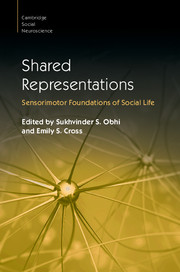Book contents
- Shared Representations
- Cambridge Social Neuroscience
- Shared Representations
- Copyright page
- Contents
- Figures
- Tables
- Boxes
- Contributors
- Preface
- Part I Foundations
- Part II Imitation and Mimicry
- Part III Thinking, Perceiving and Acting with Others
- Part IV Understanding Others
- 15 The Social Function of the Human Mirror System
- 16 Biological Tuning of Mirror Mechanisms
- 17 Representation of Self versus Others’ Actions
- 18 Reading Intention in Action
- 19 Complementary Actions
- 20 Emotional Convergence
- Part V Learning and Development
- Part VI Shared Representations in Applied Contexts
- Index
- Plate Section (PDF Only)
- References
20 - Emotional Convergence
A Case of Contagion?
from Part IV - Understanding Others
Published online by Cambridge University Press: 27 October 2016
- Shared Representations
- Cambridge Social Neuroscience
- Shared Representations
- Copyright page
- Contents
- Figures
- Tables
- Boxes
- Contributors
- Preface
- Part I Foundations
- Part II Imitation and Mimicry
- Part III Thinking, Perceiving and Acting with Others
- Part IV Understanding Others
- 15 The Social Function of the Human Mirror System
- 16 Biological Tuning of Mirror Mechanisms
- 17 Representation of Self versus Others’ Actions
- 18 Reading Intention in Action
- 19 Complementary Actions
- 20 Emotional Convergence
- Part V Learning and Development
- Part VI Shared Representations in Applied Contexts
- Index
- Plate Section (PDF Only)
- References
Summary
Because they are likely to trigger convergent emotional reactions in observers, it has become extremely common to refer to emotions as ‘contagious’ elements. While it could have simply remained a metaphor, the concept of contagion has become central to account for situations of emotional convergence between individuals. In this respect, the primitive emotional contagion model introduced by Hatfield and colleagues in 1994 assumes that we have a strong tendency to mimic the facial, postural and vocal motor behaviour of the people we interact with. This claim resembles the shared representations framework, according to which we make use of our own motor resources to access and share others’ states. This chapter consists of a critical review of the primitive emotional contagion model and further discusses the legitimacy of considering emotions as contagious elements to describe situations of affective or emotional convergence.
- Type
- Chapter
- Information
- Shared RepresentationsSensorimotor Foundations of Social Life, pp. 417 - 436Publisher: Cambridge University PressPrint publication year: 2016
References
- 7
- Cited by



